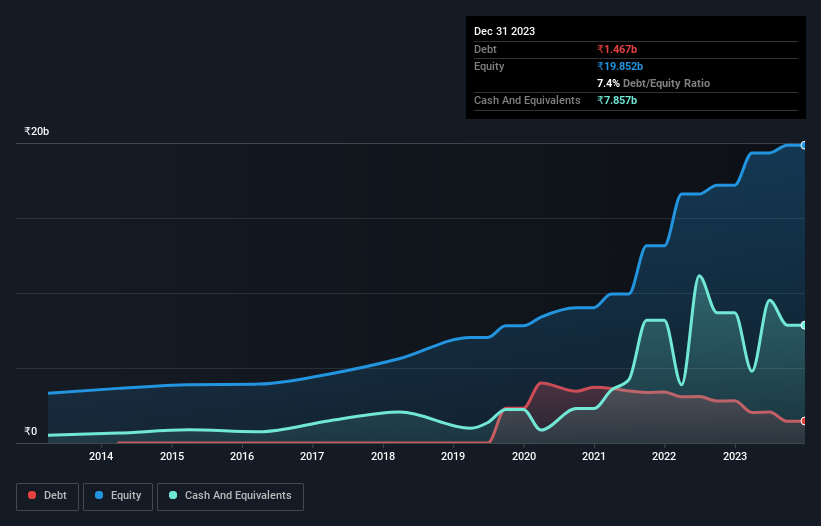- India
- /
- Metals and Mining
- /
- NSEI:SANDUMA
We Think Sandur Manganese & Iron Ores (NSE:SANDUMA) Can Stay On Top Of Its Debt

Howard Marks put it nicely when he said that, rather than worrying about share price volatility, 'The possibility of permanent loss is the risk I worry about... and every practical investor I know worries about.' So it seems the smart money knows that debt - which is usually involved in bankruptcies - is a very important factor, when you assess how risky a company is. As with many other companies The Sandur Manganese & Iron Ores Limited (NSE:SANDUMA) makes use of debt. But the real question is whether this debt is making the company risky.
Why Does Debt Bring Risk?
Debt and other liabilities become risky for a business when it cannot easily fulfill those obligations, either with free cash flow or by raising capital at an attractive price. Ultimately, if the company can't fulfill its legal obligations to repay debt, shareholders could walk away with nothing. However, a more usual (but still expensive) situation is where a company must dilute shareholders at a cheap share price simply to get debt under control. Having said that, the most common situation is where a company manages its debt reasonably well - and to its own advantage. When we think about a company's use of debt, we first look at cash and debt together.
View our latest analysis for Sandur Manganese & Iron Ores
How Much Debt Does Sandur Manganese & Iron Ores Carry?
The image below, which you can click on for greater detail, shows that Sandur Manganese & Iron Ores had debt of ₹1.47b at the end of September 2023, a reduction from ₹2.81b over a year. But it also has ₹7.86b in cash to offset that, meaning it has ₹6.39b net cash.

A Look At Sandur Manganese & Iron Ores' Liabilities
Zooming in on the latest balance sheet data, we can see that Sandur Manganese & Iron Ores had liabilities of ₹2.41b due within 12 months and liabilities of ₹1.44b due beyond that. Offsetting these obligations, it had cash of ₹7.86b as well as receivables valued at ₹373.1m due within 12 months. So it actually has ₹4.38b more liquid assets than total liabilities.
This surplus suggests that Sandur Manganese & Iron Ores has a conservative balance sheet, and could probably eliminate its debt without much difficulty. Simply put, the fact that Sandur Manganese & Iron Ores has more cash than debt is arguably a good indication that it can manage its debt safely.
The good news is that Sandur Manganese & Iron Ores has increased its EBIT by 3.1% over twelve months, which should ease any concerns about debt repayment. When analysing debt levels, the balance sheet is the obvious place to start. But you can't view debt in total isolation; since Sandur Manganese & Iron Ores will need earnings to service that debt. So if you're keen to discover more about its earnings, it might be worth checking out this graph of its long term earnings trend.
Finally, a company can only pay off debt with cold hard cash, not accounting profits. While Sandur Manganese & Iron Ores has net cash on its balance sheet, it's still worth taking a look at its ability to convert earnings before interest and tax (EBIT) to free cash flow, to help us understand how quickly it is building (or eroding) that cash balance. During the last three years, Sandur Manganese & Iron Ores produced sturdy free cash flow equating to 59% of its EBIT, about what we'd expect. This cold hard cash means it can reduce its debt when it wants to.
Summing Up
While it is always sensible to investigate a company's debt, in this case Sandur Manganese & Iron Ores has ₹6.39b in net cash and a decent-looking balance sheet. So is Sandur Manganese & Iron Ores's debt a risk? It doesn't seem so to us. The balance sheet is clearly the area to focus on when you are analysing debt. But ultimately, every company can contain risks that exist outside of the balance sheet. For example, we've discovered 1 warning sign for Sandur Manganese & Iron Ores that you should be aware of before investing here.
At the end of the day, it's often better to focus on companies that are free from net debt. You can access our special list of such companies (all with a track record of profit growth). It's free.
New: Manage All Your Stock Portfolios in One Place
We've created the ultimate portfolio companion for stock investors, and it's free.
• Connect an unlimited number of Portfolios and see your total in one currency
• Be alerted to new Warning Signs or Risks via email or mobile
• Track the Fair Value of your stocks
Have feedback on this article? Concerned about the content? Get in touch with us directly. Alternatively, email editorial-team (at) simplywallst.com.
This article by Simply Wall St is general in nature. We provide commentary based on historical data and analyst forecasts only using an unbiased methodology and our articles are not intended to be financial advice. It does not constitute a recommendation to buy or sell any stock, and does not take account of your objectives, or your financial situation. We aim to bring you long-term focused analysis driven by fundamental data. Note that our analysis may not factor in the latest price-sensitive company announcements or qualitative material. Simply Wall St has no position in any stocks mentioned.
About NSEI:SANDUMA
Sandur Manganese & Iron Ores
Together with its subsidiary, engages in the mining of manganese and iron ores in Deogiri village of Ballari District, Karnataka.
Outstanding track record with flawless balance sheet.
Market Insights
Community Narratives




